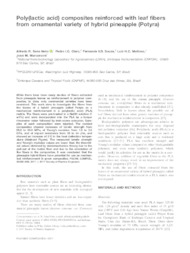Poly(lactic acid) composites reinforced with leaf fibers from ornamental variety of hybrid pineapple (Potyra).
Poly(lactic acid) composites reinforced with leaf fibers from ornamental variety of hybrid pineapple (Potyra).
Autoria: SENA NETO, A. R.; CLARO, P. I. C.; SOUZA, F. V. D.; MATTOSO, L. H. C.; MARCONCINI, J. M.
Resumo: While there have been many studies of fibers extracted from pineapple leaves as reinforcement in polymer composites, to date, only commercial varieties have been examined. This work aims to investigate the fibers from the leaves of a hybrid pineapple called Potyra as a mechanical reinforcement in a poly(lactic acid) (PLA) matrix. The fibers were pre-treated in a NaOH solution (1 wt%) and were incorporated into the PLA by a torque rheometer mixer followed by twin-screw extrusion. Samples of each composition were injected. The molded composites showed increases of tensile strength from 58.8 to 69.6 MPa, of Young?s modulus from 1.9 to 3.5 GPa, and of impact resistance from 28 to 44 J/m, and showed an increase of 58C in the heat deflection temperature (Abstract Figure). The measured tensile strength and Young?s modulus values are lower than the theoretical values obtained by micromechanics theory due to the pull-out of the matrix fiber and due to the orientation of the fibers in the composites. It was concluded that the pineapple hybrid fibers have potential for use as mechanical reinforcement in green composites. POLYM. COMPOS., 00:000?000, 2017. VC 2017 Society of Plastics Engineers
Ano de publicação: 2018
Tipo de publicação: Artigo de periódico
Unidade: Embrapa Instrumentação
Palavras-chave: Abacaxi
Observações
1 - Por padrão são exibidas publicações dos últimos 20 anos. Para encontrar publicações mais antigas, configure o filtro ano de publicação, colocando o ano a partir do qual você deseja encontrar publicações. O filtro está na coluna da esquerda na busca acima.
2 - Para ler algumas publicações da Embrapa (apenas as que estão em formato ePub), é necessário ter, no celular ou computador, um desses softwares gratuitos. Sistemas Android: Google Play Livros; IOS: iBooks; Windows e Linux: software Calibre.
Acesse outras publicações
Acesse a Base de Dados da Pesquisa Agropecuária (BDPA) para consultar o acervo completo das bibliotecas da Embrapa.

